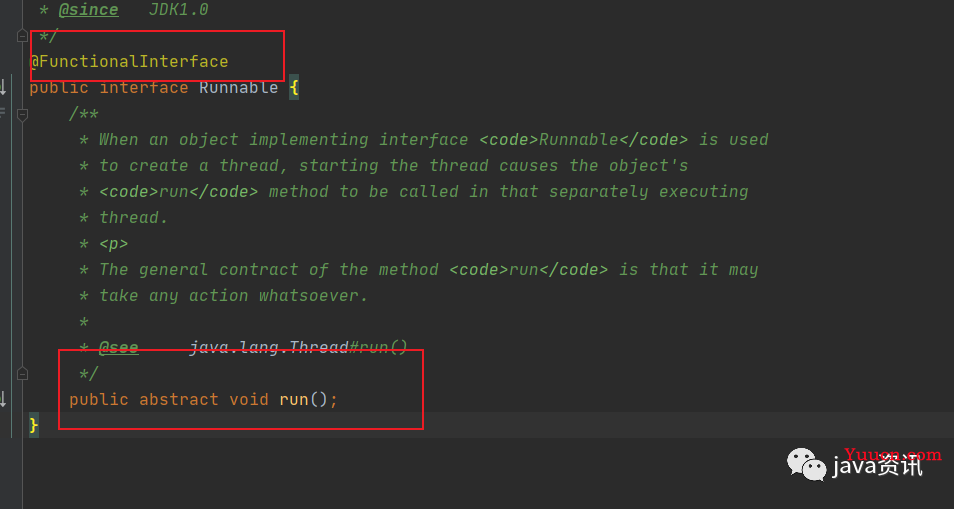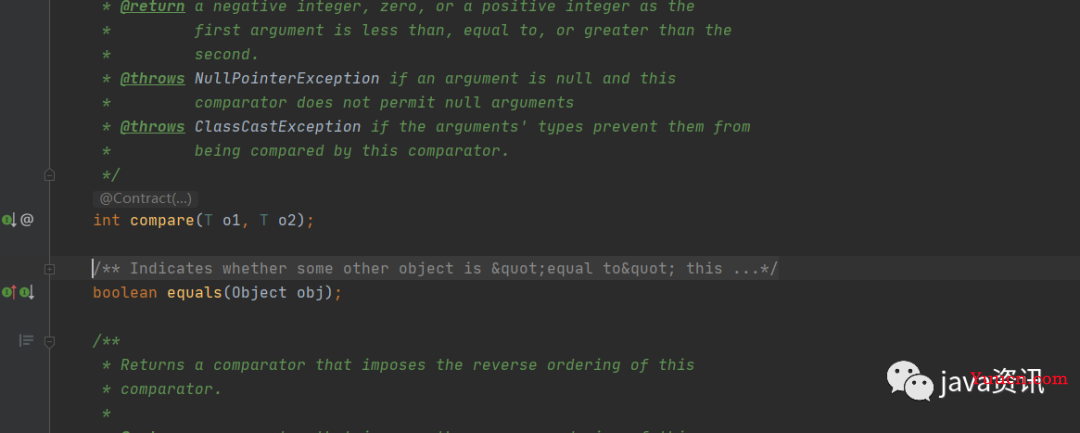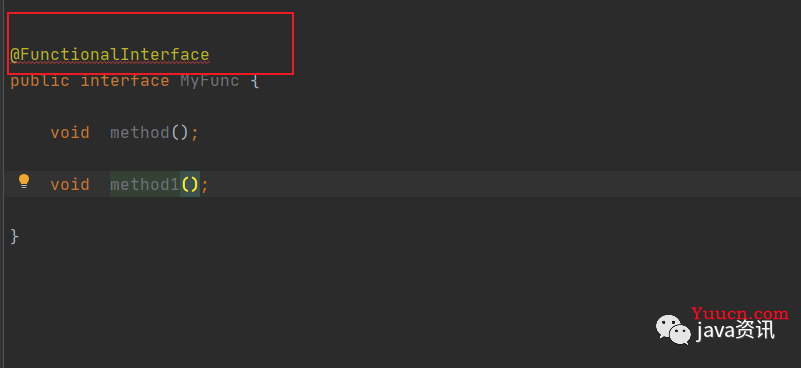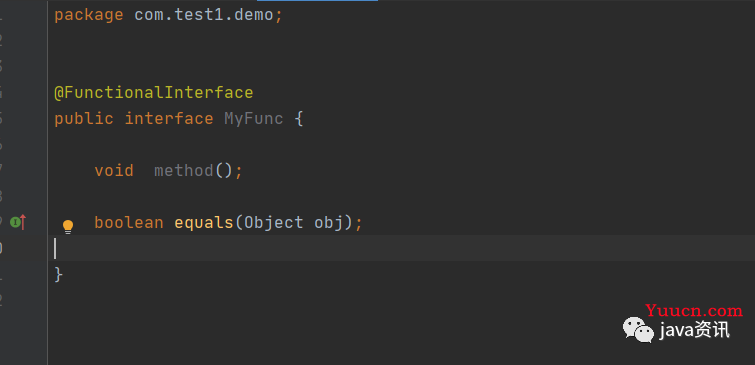java8 (jdk 1.8) 新特性 ——初步认识
1. 什么是lambda?
目前已知的是,有个箭头->
说一大段官方话,也没有任何意义
我们直接看代码:
之前我们创建线程是这样的
Runnable runnable = new Runnable() { @Override public void run() { System.out.println("run。。。。。。"); } }; runnable.run();
用lambda:
Runnable run2 = () -> System.out.println("run。。。。。。");
run2.run();

是不是感觉特别离谱,看不懂
别急,还有更离谱的
很常见的一个例子,比较两个整数的大小
之前是这样写的
Comparator<Integer> myCom = new Comparator<Integer>() {
@Override
public int compare(Integer o1, Integer o2) {
return Integer.compare(o1, o2);
}
};
int compare = myCom.compare(12, 20);
int compare1 = myCom.compare(20, 12);
int compare2 = myCom.compare(20, 20);
System.out.println(compare);
System.out.println(compare1);
System.out.println(compare2);
}
用lambda:
Comparator<Integer> myCom = (o1, o2) -> Integer.compare(o1, o2); int compare = myCom.compare(12, 20); int compare1 = myCom.compare(20, 12); int compare2 = myCom.compare(20, 20); System.out.println(compare); System.out.println(compare1); System.out.println(compare2);
甚至还可以这样 (这个是方法引用)
Comparator<Integer> myCom = Integer::compare; int compare = myCom.compare(12, 20); int compare1 = myCom.compare(20, 12); int compare2 = myCom.compare(20, 20); System.out.println(compare); System.out.println(compare1); System.out.println(compare2);
第一个数比第二个数
大 :返回 1
小:返回 -1
相等:返回 0

刚接触是不是黑人问号,这是什么玩意
很好,到这,你认识到了lambda 一个缺点,可阅读性差,优点 代码简洁
小结:看到 -> lambda 看到 : :方法引用
2. lamdba 语法
-
基本语法
1. 箭头操作符 -> 或者叫做lambda 操作符
2. 箭头操作符将lambda 表达式拆分成两部分
左侧:Lambda 表达式的参数列表
右侧:Lambda 表达式中所需执行的功能 , 即 Lambda 体
3.语法格式
语法格式1:无参数,无返回值
-
() -> system.out.println("Hello Lambda")前边线程的那个例子就是
语法格式2:有一个参数 无返回值
(x)-> System.out.println(x);
若只有一个参数可以省略不写
x-> System.out.println(x);
之前的写法,没有使用lambda
Consumer<String> consumer = new Consumer<String>() {
@Override
public void accept(String s) {
System.out.println("输出的值:"+s);
}
};
consumer.accept("今天不想emo了");
使用lambda
Consumer<String> consumer = s -> System.out.println("输出的值:"+s);
consumer.accept("今天不想emo了");
语法格式3:有两个以上参数 ,并且lambda体有多条语句,有返回值
Comparator<Integer> myCom = (o1, o2) -> {
System.out.println("其他语句");
return Integer.compare(o1, o2);
};
语法格式4 lambda体中只有一条语句,return 和 大括号都可以省略不写
Comparator<Integer> com =(x,y)-> Integer.compare(x,y);
有没有发现所有的参数,都没有参数类型,之前我们写函数的时候可是要带上参数类型的
语法格式5 lambda表达式参数列表的数据类型可以省略不写,因为JVM编译器通过上下文编译推断出数据类型——类型推断
4.函数式接口
不管上面哪一种语法格式,lambda都是需要函数式接口的支持
函数式接口:接口中只有一个抽象方法的接口 称为函数式接口
可以使用一个注解@FunctionalInterface 修饰,可以检查是否是函数式接口
我们可以看看Runnable 接口 的源码
完成的接口类代码如下
/*
* Copyright (c) 1994, 2013, Oracle and/or its affiliates. All rights reserved.
* ORACLE PROPRIETARY/CONFIDENTIAL. Use is subject to license terms
/
package java.lang;
/**
* The <code>Runnable</code> interface should be implemented by any
* class whose instances are intended to be executed by a thread. The
* class must define a method of no arguments called <code>run</code>.
* <p>
* This interface is designed to provide a common protocol for objects that
* wish to execute code while they are active. For example,
* <code>Runnable</code> is implemented by class <code>Thread</code>.
* Being active simply means that a thread has been started and has not
* yet been stopped.
* <p>
* In addition, <code>Runnable</code> provides the means for a class to be
* active while not subclassing <code>Thread</code>. A class that implements
* <code>Runnable</code> can run without subclassing <code>Thread</code>
* by instantiating a <code>Thread</code> instance and passing itself in
* as the target. In most cases, the <code>Runnable</code> interface should
* be used if you are only planning to override the <code>run()</code>
* method and no other <code>Thread</code> methods.
* This is important because classes should not be subclassed
* unless the programmer intends on modifying or enhancing the fundamental
* behavior of the class.
*
* @author Arthur van Hoff
* @see java.lang.Thread
* @see java.util.concurrent.Callable
* @since JDK1.0
*/
@FunctionalInterface
public interface Runnable {
/**
* When an object implementing interface <code>Runnable</code> is used
* to create a thread, starting the thread causes the object's
* <code>run</code> method to be called in that separately executing
* thread.
* <p>
* The general contract of the method <code>run</code> is that it may
* take any action whatsoever.
*
* @see java.lang.Thread#run()
*/
public abstract void run();
}

可以看到这里面就只有一个实现,有一个注解@FunctionalInterface ,说明它就是一个函数式接口,就可以进行lambda简写
来看 Comparator 也是一样 有@FunctionalInterface注解


这里可能就会有疑问,这边明明是有两个抽象方法,怎么是函数式接口呢?
别急 !!可以看到这边的注释, 说明这个equals 是 重写了超类 的 equals,本质上是对object 的重写,官方定义这样的抽象方法是不会被定义到 抽象接口数的 ,因此实际上只有一个抽象方法

我们自己可以试着定义 函数式接口,很简单
package com.test1.demo;
@FunctionalInterface
public interface MyFunc {
void method();
}
好了,如果,写两个抽象接口会怎样?

可以看到注解报错了,所以注解用来校验作用就在这
重申一遍,函数式接口:接口中只有一个抽象方法的接口 称为函数式接口
注解只是拿来校验的,方便我们一看就知道这是一函数式接口类,不然还得数个数,验证一下是不是只有一个
现在我也重写equals ,可以看到并没有报错

5. java8 中内置四大核心函数式接口
-
Consumer<T> 消费型接口
//Consumer 消费型接口
@Test
public void testConsumer() {
cosumer(1000, (m) -> System.out.println("星期一" + m));
// 星期一1000.0
}
public void cosumer(double m, Consumer<Double> con) {
con.accept(m);
}
-
供给型接口 supplier<T>
@Test
public void testSupplier() {
List<Integer> numList = getNumList(10, () -> (int) (Math.random() * 100));
for (Integer integer : numList) {
System.out.println(integer); //100 以内10位随机整数
}
}
// 需求:产生指定个数的整数放入集合中
public List<Integer> getNumList(int num, Supplier<Integer> su) {
List<Integer> list = new ArrayList<>();
for (int i = 0; i < num; i++) {
Integer integer = su.get();
list.add(integer);
}
return list;
}
-
Function<T,R> 函数型接口
@Test
public void FunctioStr(){
String c = getFunction("sbjikss", str -> str.toUpperCase());
System.out.println(c); //SBJIKSS
String sub = getFunction("sbjikss", str -> str.substring(2, 3));
System.out.println(sub);//j
}
public String getFunction( String str, Function<String,String> f) {
return f.apply(str);
}
-
断言型接口 Predicate<T>
public void tetPre(){
List<String> list = Arrays.asList("Hello","sss","xxxx","sjjss");
List<String> list1 = filterStr(list, (pre) -> pre.length() > 3);
for (String s : list1) {
System.out.println(s); // Hello xxxx sjjss
}
}
//需求:将满足条件字符串放入集合中
public List<String> filterStr(List<String> old , Predicate<String> pre ){
List<String> newList = new ArrayList<>();
for (String str : old) {
if (pre.test(str)){
newList.add(str);
}
}
return newList;
}
感谢阅读!!!